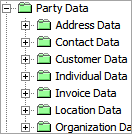The following section details what attributes are used to create the data model.
Attribute Groups
Attributes should be organized into domain specific attribute groups. Typically, these domains include:

- Entity Type: Address Data Containers; Domain Folder: Address Data
| Attribute Name | Attribute ID |
|---|---|
| Formatted Address | CalcFormattedAddress |
| Country ISO Code | CountryISOCode |
| City | InputCity |
| Country | InputCountry |
| State | InputState |
| Street | InputStreet |
| Zip | InputZip |
| Latitude | Latitude |
| Longitude | Longitude |
| Quality | Quality |
| Quality Index | QualityIndex |
| Standardized City | StandardizedCity |
| Standardized Country | StandardizedCountry |
| Standardized Country ISO Code | StandardizedCountryISOCode |
| Standardized Formatted Address | StandardizedFormattedAddress |
| Standardized State | StandardizedState |
| Standardized Street | StandardizedStreet |
| Standardized Zip | StandardizedZip |
| Validation Hash | ValidationHash |
| Validation Integration Status | ValidationIntegrationStatus |
| Validation Response | ValidationResponse |
| Validation Time | ValidationTime |
Note: For US addresses, Address1 should always be used since the US reference data does not use a postal box. The PostBox field can be used for countries whose reference data does contain a PO box.
- Entity Type: Individual Customer; Domain Folder: Individual Data
| Attribute Name | Attribute ID |
|---|---|
| Birth Date | BirthDate |
| CalcAQI | CalcAQI |
| CalcHouseholdMembers | CalcHouseholdMembers |
| Calc Individual Name | CalcName |
| Name on Collection | CalcNameCollection |
| Creation Date | CreationDate |
| Credit Limit | CreditLimit |
| Deactivated Record | DeactivatedRecord |
| First Name | FirstName |
| Gender | Gender |
| Golden Record ID | GoldenRecordID |
| Good Person Flag | GoodPersonFlag |
| Income | Income |
| Income Update Date | IncomeUpdateDate |
| Last Name | LastName |
| LastUpdated | LastUpdated |
| Matching Source | MatchingSource |
| Middle Name | MiddleName |
| Nationality | Nationality |
| Past Due Days | PastDueDays |
| Past Due Dollars | PastDueDollars |
| Risk Flag | RiskFlag |
| Sibling Delinquency Flag | SiblingDelinquencyFlag |
Note: For US addresses, 'Address1' should always be used because US reference data does not use postbox. The 'PostBox' field can be used for countries whose reference data does contain a PO box.
- Entity Type: Organization Customer; Domain Folder: Organization Data
| Attribute Name | Attribute ID |
|---|---|
| Account Type | AccountType |
| CalcAQI | CalcAQI |
| Name on Collection | CalcNameCollection |
| CompanyVATNumber | CompanyVATNumber |
| Creation Date | CreationDate |
| Deactivated Record | DeactivatedRecord |
| Employee Size | EmployeeSize |
| Golden Record ID | GoldenRecordID |
| LastUpdated | LastUpdated |
| Legal Name | LegalName |
| NAICS Code | NAICSCode |
| Revenue Size | RevenueSize |
| SIC Code | SICCode |
- Entity Type: Supplier; Domain Folder: Supplier Data
| Attribute Name | Attribute ID |
|---|---|
| Account Type | AccountType |
| Bulk Cleanse | BulkCleanse |
| Certification | Certification |
| CompanyVATNumber | CompanyVATNumber |
| Duty Paid | DutyPaid |
| Duty Unpaid | DutyUnpaid |
| Employee Size | EmployeeSize |
| Language | Language |
| Legal Name | LegalName |
| NAICS Code | NAICSCode |
| Revenue Size | RevenueSize |
| Status | Status |
| Tax Number | TaxNumber |
- Customer Source System Reference Type
| Attribute Name | Attribute ID |
|---|---|
| Source Record ID | SourceRecordID |
- Entity Type: Household
| Attribute Name | Attribute ID |
|---|---|
| Last Name | LastName |
Note: Data container types should be created under the domain with which they are used.
These attributes can be used across different object types, like where Individual and Organizational Customer records, as well as Contact data on Individual Customer, Organization Customer, and Contact Person records.
Per the general guidelines for organizing attributes in attribute groups, separate attribute groups should also be created for:
- Displaying in Web UI, to ease Web UI component setup.
- Each survivorship rule, to provide a clear definition of survivorship rules.
- Each data quality policy, to provide a clear overview of which attributes are part of each data quality metric.
- Each Object Type for each export definition, to provide a clear definition of what is exported and where.
- According to the guidelines of privilege configuration.
- Each Object Type, to describe what is included in data profiling, to ease the profiling configuration.